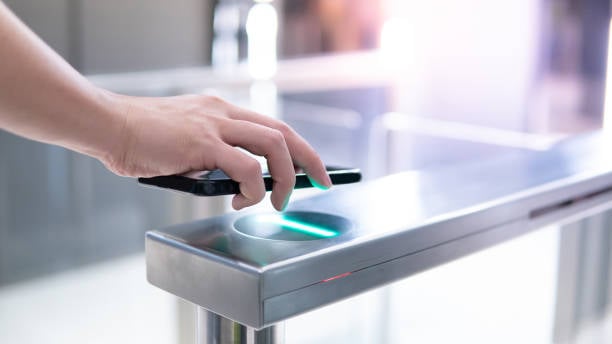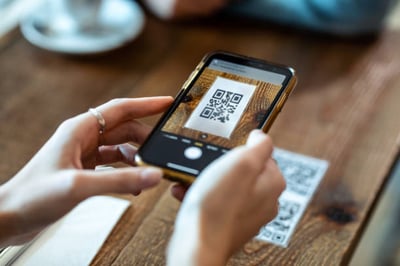April 21, 2022
 by Arpith Arun / April 21, 2022
by Arpith Arun / April 21, 2022

Today's smartphone-centric world is becoming more familiar with QR codes.
QR codes are no longer used just for what they were originally created for: tracking inventory in factories. They’re now leveraged in many ways, from marketing and real estate to digital business cards and smart packaging.
Along with this surge in business and user QR adoption, there is growing concern about the privacy and security of using QR codes. This is mainly due to attackers who use the technology as a ploy to install malware or gain unauthorized access to personal and financial data.
So are QR codes safe? And can they be dangerous?
To ease any concerns about deploying or scanning QR codes for your business, here's the long story short: As a technology, QR codes are inherently safe and secure.
But the devil’s in the finer details. Let’s first get to the nitty-gritty of QR code security.
QR codes, in their original and most basic form, are square configurations of composite black and white squares with data encoded inside.
They were developed to contain more information and data formats than their less-developed predecessor, the bar code. The ability to be easily read by a scanner was also key for Masahiro Hara at Denso Wave, the man behind QR technology. Hence the apt full form of QR is "Quick Response".
And today, almost 25 years after their introduction in the automotive supply industry, QR codes have found their way into different industries and business functions.
They now offer businesses a medium to take their audience from offline to online, allowing them to anchor endless digital content to physical touchpoints. Coupled with the ability to create custom QR codes by customizing the code color and design, QRs have become a favorite among brands looking to engage customers in new ways.
In the few years leading up to the touchless world brought about by COVID, QR codes saw a gradual increase in adoption and usage.
The primary reason for this?
QR code scanning functionality was no longer limited to third-party applications on smartphones. Users could whip out their smartphones, load the native smartphone camera app, point to the code – and voila – they were on their way to the encoded content!
The pandemic soon added fuel to this resurgence. COVID's contactless requirements meant that restaurants – an industry largely dependent on people eating out – had to ensure contact was avoided wherever possible. This is how the contactless version of the ancient paper menu card, the QR code menu, came about.
And over time, no-contact COVID protocols led to newer use cases emerging in different contexts. The use of QR codes has now expanded to include CPG packaging, inventory tracking, digital business cards, and more.
Along with this increase in QR code adoption, hackers, cybercriminals, and online scammers are increasingly using this technology. Should any of this warrant concern you if you’re scanning a QR code or using one in your marketing campaign?
Let’s dig a little deeper.
As mentioned earlier, QR codes are inherently a secure technology. They simply direct users to the data encoded within their native smartphone camera apps or standalone QR code readers. This data can be in the form of a website URL, a PDF file, landing page, questionnaire, video or audio, and more. The use cases are almost endless.
But wouldn't that be like manually typing a website address into a browser or clicking a link that leads to a landing page, questionnaire, or video?
Yup.
Only, in this case, the QR code scan does the heavy lifting of manually typing or clicking on links.
Essentially, a QR code is simply a gateway that seamlessly takes users from a physical touchpoint to a digital destination. No manual effort is required on the user’s part. All you have to do is point your camera at the displayed code.
Given that QR codes are, at their most basic level, a physical-digital medium, they cannot pose a security threat until users enter the digital world through them. This is similar to the exposure or vulnerability you would have from casually surfing the web on your smartphone, tablet, or computer – nothing more.
But since they’re widely deployed as a digital portal in the physical world, attackers with malicious intent usually find new ways to hack into your device or use social engineering to get your private information.
So, you should understand QR code security from both a user's and a company's perspective as a physical-to-digital gateway.
It's important to understand how QR code tracking works and how the technology can benefit businesses by collecting data they allow.
Here's a clear breakdown. When a user scans a QR code, data is only collected at scanning. And this refers to all information that a QR code solution provider can collect. This includes the total number of scans, the number of unique scans, timestamps, the device's operating system, and so on.
"QR code tracking" is simply akin to a data snapshot recorded at the touchpoint where the QR code is deployed.
This contradicts the prevalent myth that using QR codes can compromise your privacy and digital security. Again, just a misunderstanding! Scanning a QR code doesn't enable a live tracker on the user's phone. QR code generators cannot, in any way, obtain your personally identifiable information (PII) or place a tracker to monitor your live location or other activity.
Deploying QR codes with a solution that offers robust backend tracking analytics gives you the opportunity to build a sophisticated first-party data warehouse for your business.
First-party data collected directly from brand-user interactions provides useful insights to streamline your marketing efforts and gives you a better understanding of your target audience or audience from an overarching business intelligence perspective.
And as tech giants like Apple and Google prioritize user privacy and security, it's essential ever for businesses to leverage newer channels like QR codes to make it easier to engage with their core audiences.
Browsers like Safari, Firefox, and Brave no longer support third-party cookies, and Chrome is about to join the list of a cookieless future.
QR codes offer an alternative and seamless way to build leads and collect first-party data about users from the physical world in a tech climate heavily focused on user privacy. Businesses also benefit from self-selection that occurs in those who scan their QR codes, meaning they collect data on high-intent users who are more likely to become customers.
Why? When someone pulls out their smartphone to scan your codes and interact with your digital content, you can reliably qualify them as high intent!
Now that we've covered how QR codes work and the data companies can collect, let's get to the heart of QR code security risks.
QR codes themselves don’t pose an intrinsic data security risk, but the digital target they refer to does.
Here are some ways scammers and hackers exploit QR codes:
To stay secure, make sure the QR code you scan is safe. The good news is that there are a few things to look out for when scanning a QR code. These ensure you’re not vulnerable to hacks or fraud and minimize the extent to which you’re exposed to cyber attacks.
While ensuring your audience's digital security is paramount, you may also want to go the extra mile to make sure users can conveniently scan your codes. Finally, you need as many people as possible to scan your digital content via QR codes. This can only happen when your target audience is confident that the code they’re about to scan is safe and secure.
QR code security concerns can turn users away or expose them to vulnerabilities. Let's look at some best practices for users and businesses alike to ensure QR code security.
Here are some best practices to follow as a user looking to scan a QR code:
Instilling confidence about your QR codes’ security among your audience can increase scan and conversion rates. Here are some guidelines and best practices to follow.
Incorporate every aspect of your unique branding kit into the QR code design and use consistent QR code templates. This includes adding colors, gradient patterns, company logos, and custom borders, all in line with your brand identity. Ensuring the landing page that the QR code instantly links to also matches your brand can be a huge plus.
Make sure your code contains your custom brand or company domain if you have the option. Free online QR code generators allow you to create static QR codes that link to your domain. And all too often, these codes have URLs that contain lots of alphanumeric characters, a major put-off to a user who might actually be interested in your QR-linked digital content.
Make sure the website the QR code links to is SSL certified and encrypted. SSL certificates signal your users that their data is safe and prevent attackers from creating fake versions of your website. Users will now see "http://” or anything other than "https://" as warning signs. Website browsers mark websites without an SSL certificate as "not secure".
Your QR code generator should comply with the General Data Protection Regulation (GDPR) and other applicable data privacy laws. If your QR code partner is GDPR compliant, they should protect your data from outsiders or other third parties.
A secure QR code generator always offers enterprise-level security protection with data encryption, limiting access to personal information and data confidentiality.
If sensitive data is shared via the QR code channel, grant access to the encrypted content to a select group of people and no one else. Password gating allows you to do this, especially when exchanging confidential information like bank statements and essential personal identification documents.
Your QR code solution provider should be SOC-2 Type-1 and SOC-2 Type-2 certified. The SOC 2 certification was developed by the American Institute of Certified Public Accountants as an assessment method for the secure management of data by companies. Sharing the same with your customers will serve as a strong endorsement of your QR code's security when scanned.
It’ll help if your QR code generator has a single-sign-on (SSO) login. As a business looking to engage your audience through QR codes, you may be involved in their creation and editing at scale. To ensure high-volume security, you need SSO capability so that only those with permission to access the code management platform can actually use it.
To reiterate, there’s nothing built into QR codes that makes them more dangerous than using a web browser or an application on your smartphone. However, QR codes can be cleverly tinkered with as an offline-to-online channel for cybercriminals and other malicious actors.
It’s vital to ensure that QR code security best practices are followed from both a user and business perspective. As mentioned earlier, users need to look for ways to determine the security and authenticity of a QR code scan. And for businesses, communicating and signaling the authenticity of their codes is critical to getting more scans, clicks, and ultimately conversions.
Managing and protecting digital identities is as important as any other form of security. Learn more about identity and access management.
Arpith Arun is a Content Marketer at Mobstac. When he's not writing, he's mostly playing the guitar, watching football, or catching up on MMA highlights.
Back in 2020, QR Codes made a dramatic comeback.
 by Shruti Nair
by Shruti Nair
QR codes are now a familiar sight.
 by Christine Joy Santiago
by Christine Joy Santiago
You’re at a restaurant. The waiter points to a laminated card that says, “Scan for menu.” You...
 by Harshita Tewari
by Harshita Tewari
Back in 2020, QR Codes made a dramatic comeback.
 by Shruti Nair
by Shruti Nair
QR codes are now a familiar sight.
 by Christine Joy Santiago
by Christine Joy Santiago


